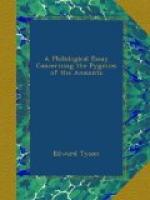The subject of Pigmy races and fairy tales cannot be considered to have been in any sense fully treated without some consideration of a theory which, put forward by various writers and in connection with the legends of diverse countries, has recently been formulated by Mr. MacRitchie in a number of most interesting and suggestive books and papers. An early statement of this theory is to be found in a paper by Mr. J.F. Campbell, in which he stated, “It is somewhat remarkable that traditions still survive in the Highlands of Scotland which seem to be derived from the habits of Scotch tribes like the Lapps in our day. Stories are told in Sutherlandshire about a ‘witch’ who milked deer; a ‘ghost’ once became acquainted with a forester, and at his suggestion packed all her plenishing on a herd of deer, when forced to flit by another and a bigger ‘ghost;’ the green mounds in which ‘fairies’ are supposed to dwell closely resemble the outside of Lapp huts. The fairies themselves are not represented as airy creatures in gauze wings and spangles, but they appear in tradition as small cunning people, eating and drinking, living close at hand in their green mound, stealing children and cattle, milk and food, from their bigger neighbours. They are uncanny, but so are the Lapps. My own opinion is that these Scotch traditions relate to the tribes who made kitchen-middens and lake-dwellings in Scotland, and that they were allied to Lapps."[A] Such in essence is Mr. MacRitchie’s theory, which has been so admirably summarised by Mr. Jacobs in the first of that series of fairy-tale books which has added a new joy to life, that I shall do myself the pleasure of quoting his statement in this place. He says: “Briefly put, Mr. MacRitchie’s view is that the elves, trolls, and fairies represented in popular tradition are really the mound-dwellers, whose remains have been discovered in some abundance in the form of green hillocks, which have been artificially raised over a long and low passage leading to a central chamber open to the sky. Mr. MacRitchie shows that in several instances traditions about trolls or ‘good people’ have attached themselves to mounds which long afterwards, on investigation, turned out to be evidently the former residence of men of smaller build than the mortals of to-day. He goes on further to identify these with the Picts— fairies are called ‘Pechs’ in Scotland—and other early races, but with these ethnological equations we need not much concern ourselves. It is otherwise with the mound traditions and their relation, if not to fairy tales in general, to tales about fairies, trolls, elves, &c. These are very few in number, and generally bear the character of anecdotes. The fairies, &c., steal a child; they help a wanderer to a drink and then disappear into a green hill; they help cottagers with their work at night, but disappear if their presence is noticed; human midwives are asked to help fairy mothers; fairy maidens marry ordinary




